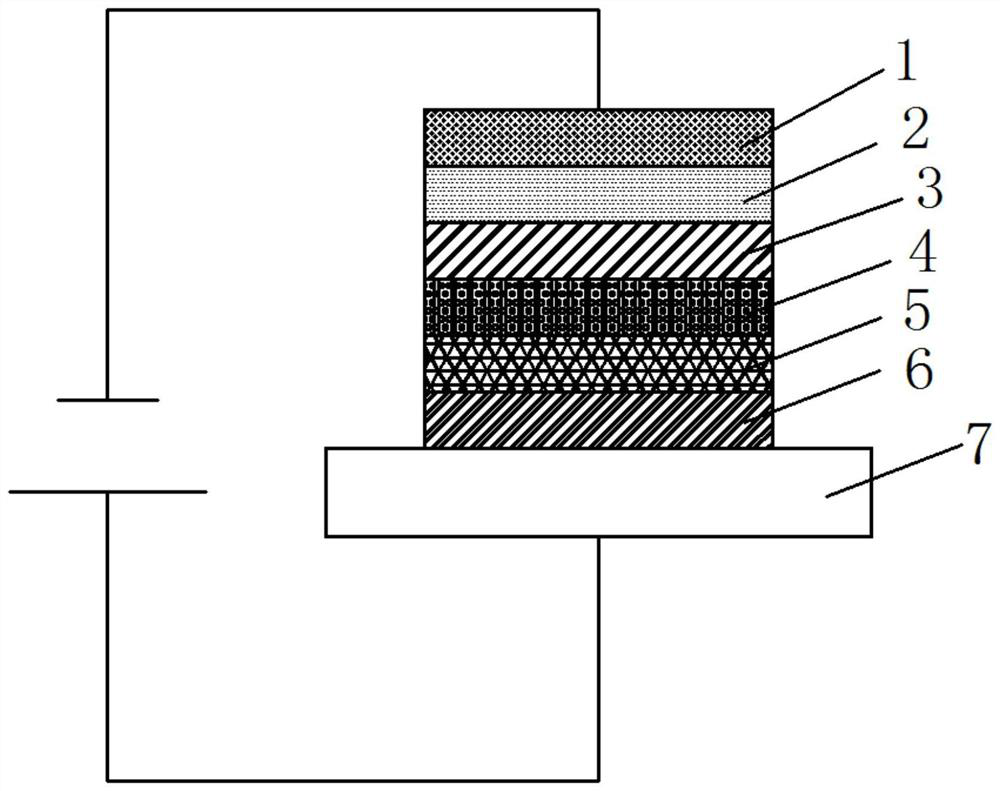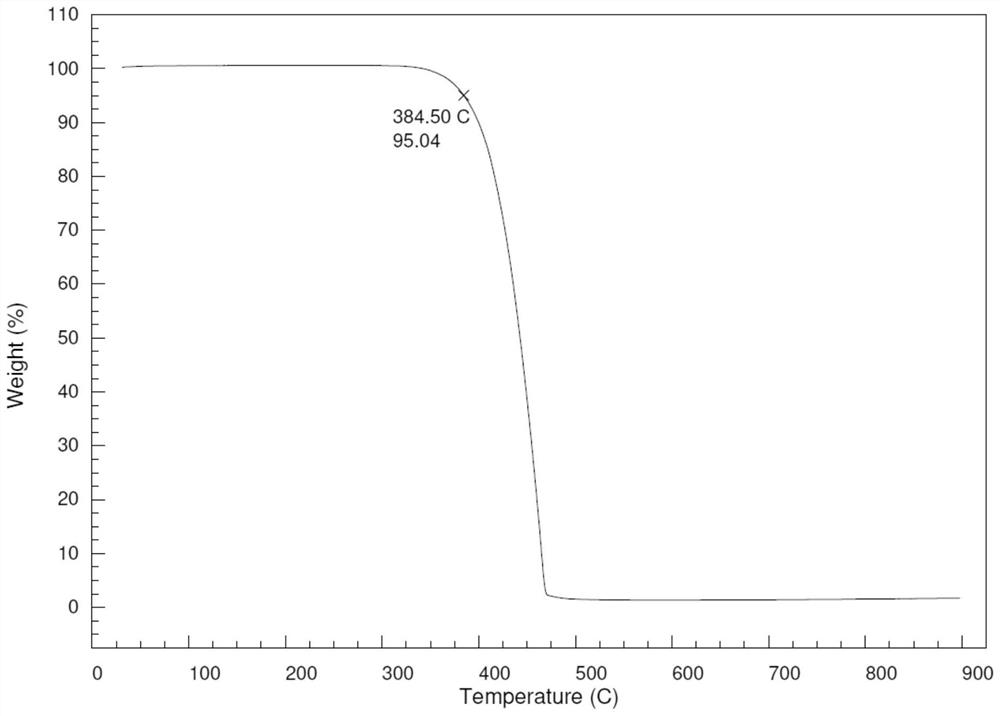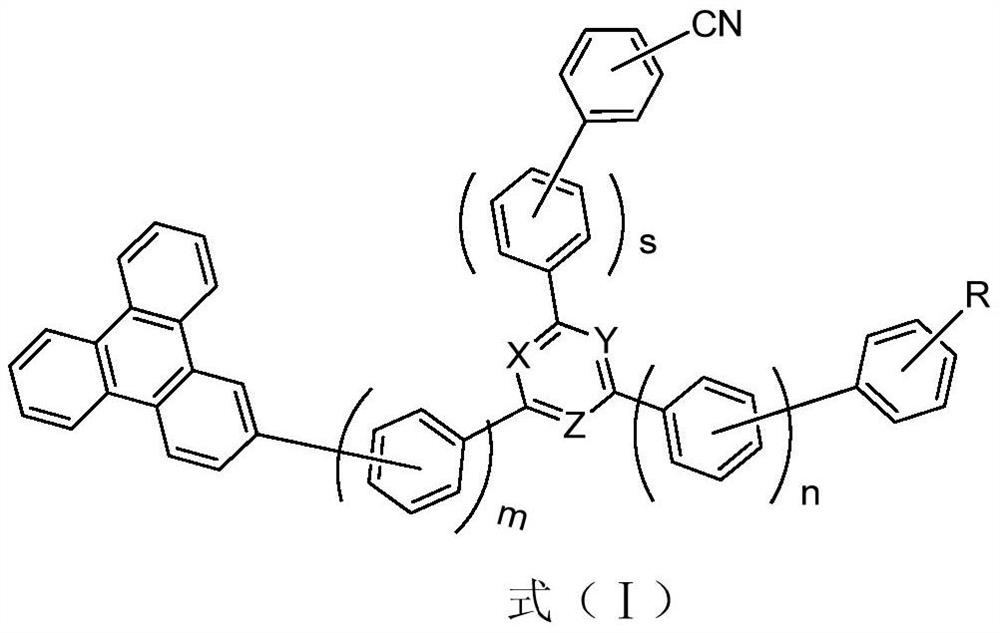Triphenyl-based organic compound, organic electroluminescent material and device
An organic compound, triphenylene technology, applied in luminescent materials, organic chemistry, electro-solid devices, etc., can solve the problems of short service life, low luminous efficiency, high starting voltage, and achieve improved efficiency, high electron mobility, reduced Effect of driving voltage
- Summary
- Abstract
- Description
- Claims
- Application Information
AI Technical Summary
Problems solved by technology
Method used
Image
Examples
Embodiment 1
[0044]
[0045] The synthetic method of organic compound (1) is as follows:
[0046] S1:
[0047]
[0048] Compound 1-a (5g, 317.76g / mol, 15.89mmol), compound 1-b (1.1eq, 2.57g, 146.94g / mol, 17.47mmol) and sodium carbonate (2eq, 3.37g, 105.99g / mol, 31.77mmol) was added to ethylene glycol diamine ether (100g, 20 times the quality of compound 1-a) and water (100g, 20 times the quality of compound 1-a), stirred and mixed and then added three (o-toluene Base) phosphine (5%eq, 0.24g, 304.37g / mol, 0.79mmol) and palladium (II) acetate (1%eq, 0.04g, 224.51g / mol, 0.16mmol), after warming up to reflux for 15h, the The organic phase was separated, washed with water, and concentrated under reduced pressure to obtain a crude product, which was subjected to column chromatography to obtain compound 1-c (4.96 g, yield 91.8%), MS (EI): 339 (M+).
[0049] S2:
[0050]
[0051] Compound 1-c (4g, 339.97g / mol, 11.84mmol), compound 1-d (1.1eq, 4.53g,
[0052] 348.20g / mol, 13.02mmol) an...
Embodiment 2
[0057]
[0058] The synthetic method of organic compound (6) is as follows:
[0059]
[0060] Compound 2-a (4g, 563.45g / mol, 7.12mmol), compound 2-b (1.1eq, 1.39g, 178.04g / mol, 7.83mmol) and sodium carbonate (2eq, 1.51g, 105.99g / mol, 14.23mmol) into ethylene glycol diamine ether (80g, 20 times the quality of compound 2-a) and water (80g, 20 times the quality of compound 2-a), stir and mix and then add tri(o-toluene Base) phosphine (5%eq, 0.11g, 304.37g / mol, 0.36mmol) and palladium (II) acetate (1%eq, 0.02g, 224.51g / mol, 0.07mmol), after warming up to reflux for 15h, the The organic phase was separated, washed with water, and concentrated under reduced pressure to obtain a crude product, which was subjected to column chromatography to obtain an organic electroluminescent material (6) (3.79 g, yield 86.5%), MS (EI): 616 (M+).
Embodiment 3
[0062]
[0063] The synthetic method of organic compound (7) is as follows:
[0064]
[0065] Compound 3-a (4g, 563.45g / mol, 7.12mmol), compound 3-b (1.1eq, 1.55g, 198.03g / mol, 7.83mmol) and sodium carbonate (2eq, 1.51g, 105.99g / mol, 14.23mmol) into ethylene glycol diamine ether (80g, 20 times the quality of compound 3-a) and water (80g, 20 times the quality of compound 3-a), stir and mix and then add tri(o-toluene Base) phosphine (5%eq, 0.11g, 304.37g / mol, 0.36mmol) and palladium (II) acetate (1%eq, 0.02g, 224.51g / mol, 0.07mmol), after warming up to reflux for 15h, the The organic phase was separated, washed with water, and concentrated under reduced pressure to obtain a crude product, which was subjected to column chromatography to obtain an organic electroluminescent material (7) (3.9 g, yield 86.1%), MS (EI): 636 (M+).
PUM
| Property | Measurement | Unit |
|---|---|---|
| thickness | aaaaa | aaaaa |
Abstract
Description
Claims
Application Information
 Login to View More
Login to View More - R&D
- Intellectual Property
- Life Sciences
- Materials
- Tech Scout
- Unparalleled Data Quality
- Higher Quality Content
- 60% Fewer Hallucinations
Browse by: Latest US Patents, China's latest patents, Technical Efficacy Thesaurus, Application Domain, Technology Topic, Popular Technical Reports.
© 2025 PatSnap. All rights reserved.Legal|Privacy policy|Modern Slavery Act Transparency Statement|Sitemap|About US| Contact US: help@patsnap.com



